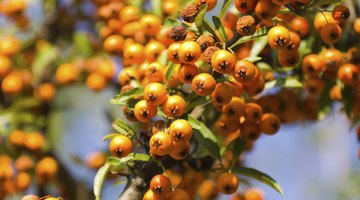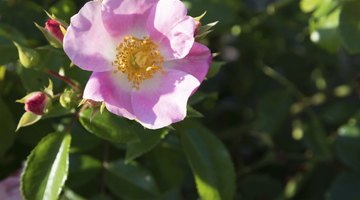Shrubs That Provide Home Security
When you consider adding landscape shrubs to your home defense arsenal, you need to plan carefully. Hedges can provide cover for burglars to scope your property if too tall or in the wrong place. Some communities have ordinances about how tall a hedge can be.

Consider what it takes to maintain a barrier planting; if it's formidable to burglars, it could also be formidable to prune. Home security advisors recommend limiting planting by windows and doors to 3 feet tall for better visibility.
Low-Growing Shrubs

A ground-hugging plant with prickly leaves or spines planted under windows discourages entry and also offloading stolen goods out through the window. Low bushes allow neighbors to spot suspicious movements and you to see out. "Crimson Pygmy" Dwarf Japanese Barberry (Berberis thunbergii "Crimson Pygmy"), which grows in U.S. Department of Agriculture plant hardiness zones 4 through 8, grows to 2 feet high and 3 feet wide. The densely branching, thorny plant has colorful deep red leaves. Plant it in full sun.
Medium-Height Shrubs

Thickly branching, spiny shrubs are a good deterrent against a fence or wall to prevent access. It takes a few years for shrubs to form a solid barrier. Plant them more closely for quicker coverage. Firethorn "Apache" (Pyracantha hybrid "Apache") combines evergreen leaves and a dense, spiny-branched habit with white spring flowers and large red winter fruits. It grows 5 to 6 feet tall and 6 feet wide in USDA zones 7 through 11. For a really formidable spiny barrier, plant Mentor barberry (Berberis x mentorensis), which grows in USDA zones 5 through 9a. It has a naturally mounding growth habit and rarely needs pruning, growing 3 to 6 feet tall and 4 to 7 feet wide.
Sharp-Leaved Shrubs

A few shrubs useful as barriers have spiny leaves instead of spiny stems. An example is "Gold Coast" English holly (Ilex aquifolium "Monvila"), which is shorter than many other holly species, reaching only 4 to 6 feet. Variegated leaves give year-long interest. The bush is male, so it doesn't produce berries. Hardy in USDA zones 6 through 9, this is a slow-growing plant. Also with prickly leaves is "Charity" mahonia (Mahonia x media "Charity"), growing in USDA zones 7 through 9. Sharply pointed, evergreen leaves have impressive, frondlike growth from the stems. It flowers in winter when garden color is scarce, with yellow flowers followed by black berries. "Charity" can grow 10 to 15 feet tall and needs pruning to keep it to size.
Large-Flowered Shrubs

For a combination of security and ornamental spring flowers, train a shrubby rose against or through an open fence to make it impossible to climb. One candidate is rugosa rose (Rosa rugosa), which grows in USDA zones 3 through 9. The deciduous bush has large, fragrant, pink, white or red spring flowers and orange to red rose hips in late summer. Stems are thickly covered with thorns. Rugosa rose is invasive in some areas. Another good barrier rose for fences and walls, hybrid "New Dawn" (Rosa "New Dawn") has double, fragrant blush-pink flowers from spring through fall, growing in USDA zones 5 through 9. Stout, sharp thorns armor the 8- to 12-foot-long stems.
The Drip Cap
- When you consider adding landscape shrubs to your home defense arsenal, you need to plan carefully.
- Consider what it takes to maintain a barrier planting; if it's formidable to burglars, it could also be formidable to prune.
- Thickly branching, spiny shrubs are a good deterrent against a fence or wall to prevent access.
- Charity" can grow 10 to 15 feet tall and needs pruning to keep it to size.
- The deciduous bush has large, fragrant, pink, white or red spring flowers and orange to red rose hips in late summer.
- Another good barrier rose for fences and walls, hybrid "New Dawn" (Rosa "New Dawn") has double, fragrant blush-pink flowers from spring through fall, growing in USDA zones 5 through 9.
- Stout, sharp thorns armor the 8- to 12-foot-long stems.
References
- Ultimate Guide to Home Security; Daniel Berg
- Monrovia: Crimson Pygmy Dwarf Japanese Barberry
- Arizona State University: Pyracantha Hybrids
- University of Florida IFAS Extension: Berberis x Mentorensis
- Monrovia: Gold Coast English Holly
- Monrovia: Charity Mahonia
- The National Gardening Association: Edible Shrubs for Your Landscape
- Missouri Botanical Garden: Rosa "New Dawn"
Writer Bio
Carolyn Csanyi began writing in 1973, specializing in topics related to plants, insects and southwestern ecology. Her work has appeared in the "American Midland Naturalist" and Greenwood Press. Csanyi holds a Doctor of Philosophy in biology from the University of Wisconsin at Madison.
Photo Credits
- SteveDeming/iStock/Getty Images
- SteveDeming/iStock/Getty Images
- photopicturesproject/iStock/Getty Images
- Foto-Kunst-RD/iStock/Getty Images
- kwiktor/iStock/Getty Images
- ArtesiaWells/iStock/Getty Images
More Articles



